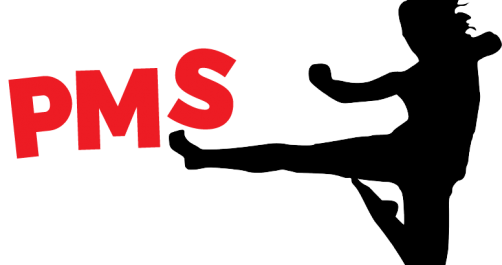Five Strategies for Beating PMS Before It Beats You
Being a woman, you no doubt have experienced PMS at some point in your life. Researchers sill do not understand why some women struggle with PMS more than others. PMS affects women of all cultures and socioeconomic levels, but types of symptoms and levels of discomfort vary from woman to woman and may have cultural influences. More than three hundred symptoms have been associated with PMS. I know the struggle is real, so I have put together 5 strategies for beating PMS before it beats you!
Did you know that a question often asked in the medical field is: “Is PMS real?”
The symptoms typically occur in the second half of the menstrual cycle, resolve after the period begins and are often absent during the early phase of the menstrual cycle. As many as 85% of menstruating women experience one or more symptoms of PMS. Approximately 5% to 10% of women have symptoms severe enough to be debilitating.
What does PMS actually stand for?
PMS stands for “Premenstrual syndrome.”
The syndrome manifests itself in a mix of physical and emotional symptoms during the one or two weeks before menstruation that can make you feel like violent world revolutions are taking place within your mind and body.
One of the first steps to making sure PMS doesn’t pull you under on your worst days is understanding it.
Causes of PMS
The exact cause of PMS is not fully understood and may be related to several factors. The current theories on the underlying causes focus mostly on levels of sex hormones (e.g., estrogen, progesterone) and neurotransmitters (i.e., brain chemicals that control mood), dietary influences and emotional factors.
Dietary Factors Influencing PMS
- Diets high in animal fats have been shown to increase prostaglandin (PGE2) production and aggravate PMS symptoms.
- Increased alcohol consumption during the premenstrual phase interferes with the liver’s ability to detoxify excess circulating hormones.
- Nutritional deficiencies such as calcium, magnesium, zinc, vitamin B6, vitamin E, and essential fatty acids contribute to PMS.
- Increased caffeine consumption causes an imbalance of cortisol and blood sugar and further inhibits the liver’s ability to balance serotonin, estrogen, and progesterone, leading to breast tenderness and swelling.
Many factors can contribute to or trigger PMS by causing hormonal changes in the body, including:
- High consumption of dairy products
- Excessive consumption of caffeine (soft drinks, coffee, chocolate)
- Excessive consumption of high glycemic foods
- A relatively high blood level of estrogen
- A relatively low blood level of progesterone
- Diet that leads to increased levels of the hormone prostaglandin F2
- Excess body weight
- Low levels of vitamins C and E
- Magnesium and/or Selenium deficiency
- Lack of exercise
#1 Strategy: Understand and Record
The symptoms of PMS vary from woman to woman, and even from cycle to cycle, but they tend to occur in somewhat predictable patterns.
Keeping track of the symptoms you experience over several cycles will help you to identify the patterns of your personal battle and equip you to identify triggers and anticipate the timing of your symptoms. Once you know what to expect, you will be more prepared to implement further strategies to deal with and lessen your symptoms.
Understand
PMS symptoms generally start to show up 6 to 10 days before menstruation and disappear once a woman’s period begins. They may be barely noticeable one month and intensely severe the next.
It’s important to understand that at least half of these symptoms are mental and emotional, as this will help you to view them from a distance, giving you greater power in controlling them.
Symptoms include:
- Tension/anxiety
- Depression
- Crying (that you can’t really explain)
- Mood swings
- Irritability/anger
- Changes in appetite/food cravings
- Insomnia
- Social withdrawal
- Poor concentration/memory, trouble thinking clearly
- Joint/muscle pain
- Headaches
- Fatigue
- Weight gain because of fluid retention
- Abdominal bloating/cramps
- Breast tenderness
- Acne flare-ups
- Constipation or diarrhea
- Nausea
Yes, the list is long, and you could probably add to it (for example, get specific with those “mood swings;” and does anyone else just feel like they have someone else’s brain for a few days and that “trouble thinking clearly” comes right on the heels of some of your sharpest ideas?).
Record
Keep track of the symptoms you recognize for at least two months. Note when they appear, how severe they are, how long they last, when you ovulate and when menstruation begins.
Record triggers you can identify and activities, foods, etc. that seem to aggravate or alleviate symptoms. You should eventually be expecting certain symptoms and have a plan in place to deal with them. Now let’s move on to a few strategies that have been proven and suggested by other PMS sufferers and medical professionals.
#2 Strategy: Eat, Drink and Be Wary
One strategy to help you deal with some of the physical discomfort associated with PMS, is to be wary of what and how much you eat and drink while your symptoms are present.
Eating small amounts several times a day, rather than two or three large meals, can reduce bloating, cramps, and nausea. Limiting your salt intake can help reduce fluid retention.
Try not to give into the crazy food cravings that may hit you—especially if they involve salty or sugary snacks, coffee, or chocolate (Argh!). Caffeine can increase your insomnia and headaches and further scramble your brain and emotions. Also, try to avoid alcohol where possible. The simple elimination of sugar has a profound effect on eradicating several symptoms associated with PMS.
Choose instead to eat wholesome foods such as:
- Fresh fruits and vegetables (especially leafy green) and whole grains.
- Calcium-rich foods like sardines, yogurt, cooked kale and broccoli.
- Foods high in vitamin E, such as almonds, sunflower seeds, and spinach.
- Fish high in omega 3 fatty acids, such as salmon, sardines and anchovies.
- Avocado: balances hormones and is high in good fat, fiber, magnesium, potassium and vitamin B6
#3 Strategy: Exercise (Naturally)
Staying active is one of the best strategies for increasing your overall health. While you may not feel like jogging around the block once PMS has hit full force, a brief walk, swim or another aerobic form of exercise can lift your mood, eradicate some fatigue and ease irritability.
Making 30 minutes a day of medium to brisk exercise a regular part of your lifestyle will benefit your entire body, mind, and spirit, leaving you ready and able to deal with PMS and lessening the affect it has on you.
#4 Strategy: Work at Relaxing
Stress just makes everything worse, so work at relaxing.
It’s an unfortunate truth that most of us are unable to fling ourselves on our bed or hide out in a dark corner whenever our inner life becomes especially painful or bewildering, so you will need to find other ways to relieve tension and ease anxiety. Turn to an activity or thought that brings you peace.
You may also wish to try some of these tips:
- Improve your posture to release stress. Sit up straight. Stand up and stretch. If you have the opportunity, lie flat on the floor, stretch out to your full length and then relax. Concentrate on each muscle one at a time, making sure none of them remain tight.
- Breathing deeply and steadily can also help you relax and de-stress. It’s helpful in pushing you toward sleep when you’re lying bed wide awake. Lie still, tune out your tumbling thoughts and just breathe.
- Some people find that journaling or writing poetry, even if it doesn’t end up making any sense, can help them relax and release tension, confusion, and anger.
#5 Strategy: Search for Alternatives
There are various effective herbal remedies and vitamin/mineral supplements recommended for dealing with PMS.
Dr Cobi’s Top Picks for PMS
Brain Mood – Take 1 capsule 2 times per day with food. This mood stabilizing supplement is very effective for regulating mood swings related to PMS
Evening Primrose Oil – 3000mg per day for 4 weeks then 1000mg per day
Vitamin E – Take 1 capsule 1 time per day. The essential fatty acids found in Vitamin E help to reduce symptoms associated with PMS such as cycle related breast tenderness.
Vitamin B6 (50-100mg per day) P5P, the activated form of Vitamin B6 is essential for the synthesis of steroid hormones, particularly progesterone. It’s involved in the manufacture of the key neurotransmitters GABA and serotonin which help to calm the body.
Magnesium (150mg per day) works together with B6 to manufacture progesterone. Magnesium also calms the nervous system. The best form is magnesium glycinate because of the additional benefits of glycine itself. Glycine is a calming neurotransmitter and is also involved in estrogen detoxification.
Fem Guard – Take 2 capsules 2 times per day with food. This herbal and nutrient combination has all of the supportive nutrients needed to balance the hormones associated with PMS.
If you have ever struggled with PMS, you know it is real, and it can be powerful. You can beat it before it beats you, though. Just remember that by taking control and implementing these key measures, you’ll be able to beat it rather than letting it defeat you month after month.

